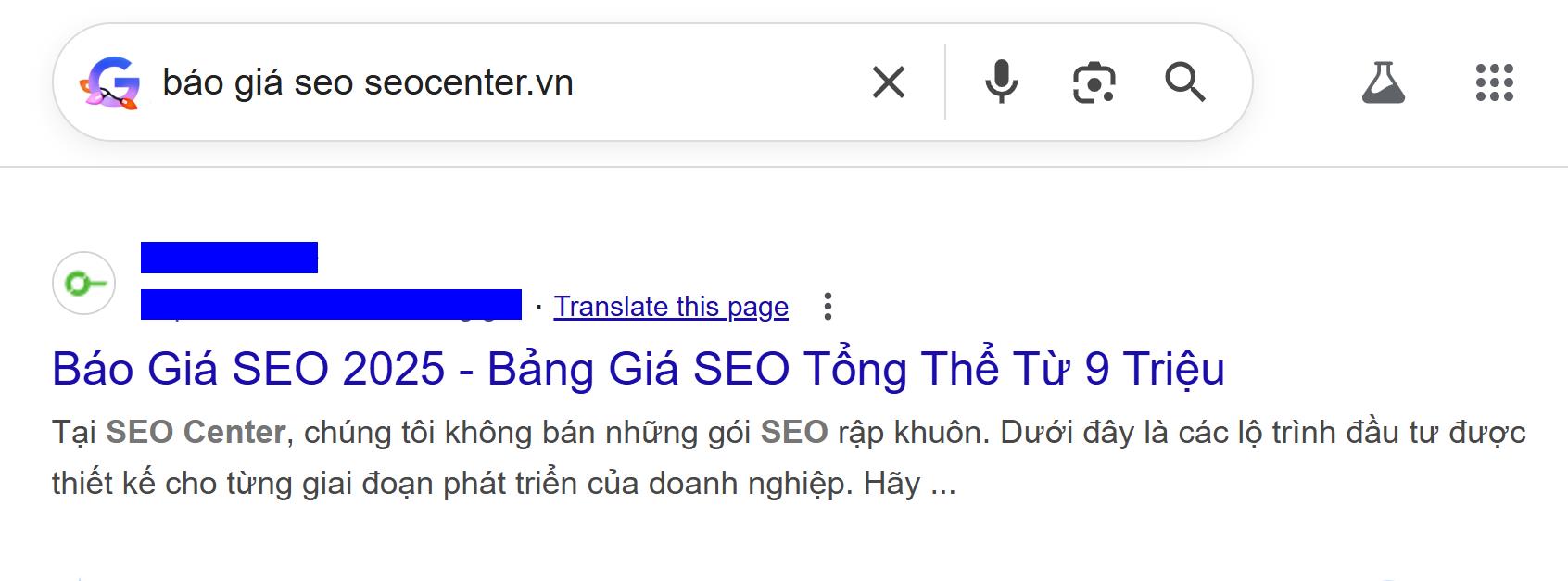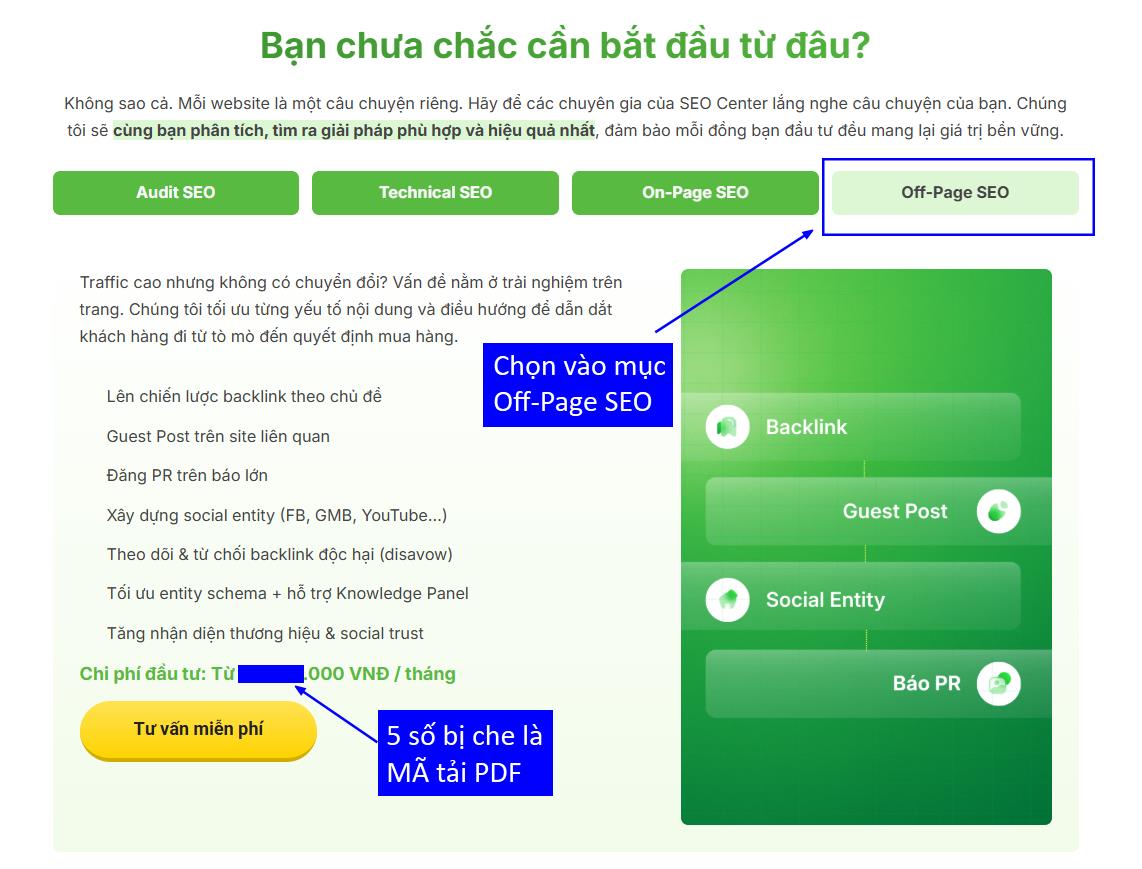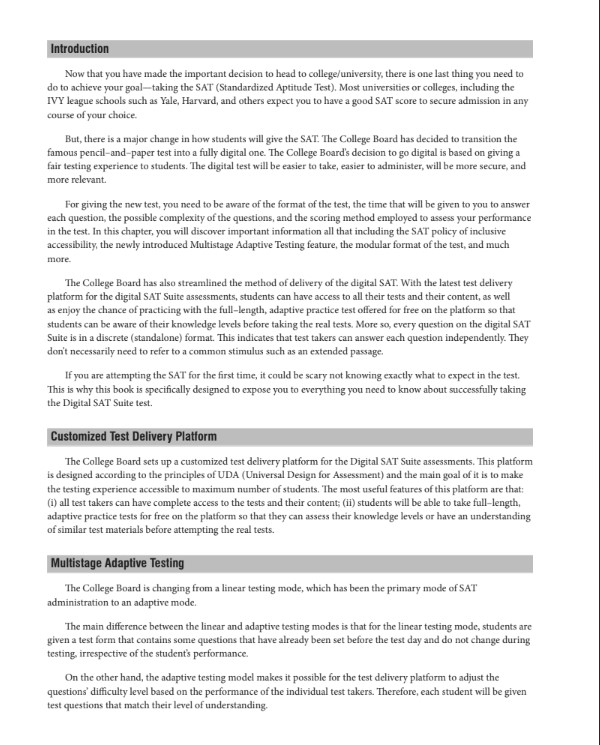
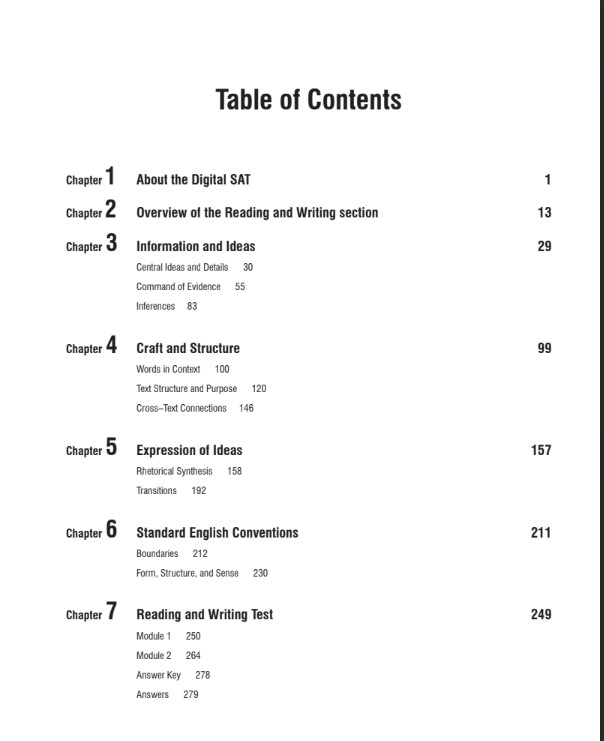
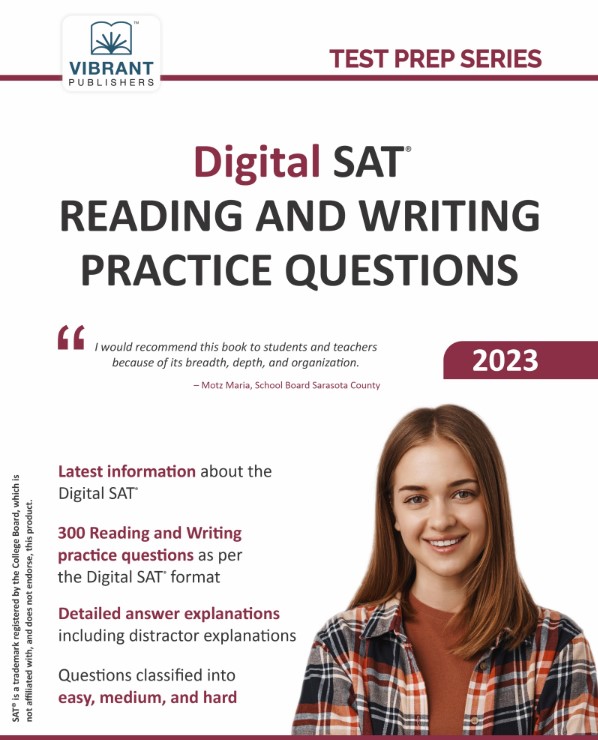
Bild 1: Table of Contents
Table of Contents
Chapter 1 About the Digital SAT ………………………………………………… 1
Chapter 2 Overview of the Reading and Writing section ………………… 13
Chapter 3 Information and Ideas ………………………………………………. 29
Central Ideas and Details …………………………………………………. 30
Command of Evidence ……………………………………………………….. 55
Inferences …………………………………………………………………………. 83
Chapter 4 Craft and Structure …………………………………………………… 99
Words in Context ……………………………………………………………… 100
Text Structure and Purpose ………………………………………………. 120
Cross-Text Connections ……………………………………………………. 146
Chapter 5 Expression of Ideas …………………………………………………… 157
Rhetorical Synthesis ………………………………………………………… 158
Transitions ……………………………………………………………………….. 192
Chapter 6 Standard English Conventions ……………………………………. 211
Boundaries ………………………………………………………………………. 212
Form, Structure, and Sense ………………………………………………. 230
Chapter 7 Reading and Writing Test …………………………………………. 249
Module 1 …………………………………………………………………………. 250
Module 2 …………………………………………………………………………. 264
Answer Key ……………………………………………………………………… 278
Answers …………………………………………………………………………… 279
Bild 2: Introduction: How to Use This Book
Introduction
Now that you have made the important decision to head to college/university, there is one last thing you need to do to achieve your goal—taking the SAT (Standardized Aptitude Test). Most universities or colleges, including the Ivy League schools such as Yale, Harvard, and others expect you to have a good SAT score to secure admission in any course of your choice.
But, there is a major change in how students will give the SAT. The College Board has decided to transition the famous pencil-and-paper test into a fully digital one. The College Board’s decision to go digital is based upon giving a fair testing experience to students. The digital test will be easier to take, easier to administer, will be more secure, and more relevant.
For receiving the free test, you need to be aware of the format of the test, the time that will be given to you to answer each question, the possible complexity of the questions, and the scoring method employed to assess your performance in the test. In this chapter, you will discover important information all that including the SAT policy of inclusive accessibility, the newly introduced Multistage Adaptive Testing feature, the modular format of the test, and much more.
The College Board has also streamlined the method of delivery of the digital SAT. With the latest test delivery platform for the Digital SAT Suite assessments, students can have access to all their tests and their content, as well as enjoy the practice of full-length, adaptive practice test offered for free on the platform so that students can be aware of their knowledge levels before taking the real tests. Moreover, every question on the digital SAT Suite is in a discrete (standalone) format. This indicates that students take the answer each question independently. They don’t necessarily need to refer to a common stimulus such as an extended passage.
If you are attempting the SAT for the first time, it could be scary not knowing exactly what to expect in the test. This is why this book is specifically designed to expose you to everything you need to know about successfully taking the Digital SAT Suite test.
Customized Test Delivery Platform
The College Board has set up a customized test delivery platform for the Digital SAT Suite assessments. This platform is designed according to the principles of UDA (Universal Design for Assessment) and the main goal of it is to make the testing experience accessible to the maximum number of students. The most useful features of this platform are that: (i) all test takers can have complete access to the tests and their content; (ii) students will be able to take full-length, adaptive practice tests for free on the platform so that they can assess their knowledge levels or have an understanding of similar test materials before attempting the real tests.
Multistage Adaptive Testing
The College Board is changing from a linear testing mode, which has been the primary mode of SAT administration to an adaptive mode.
The main difference between the linear and adaptive testing modes is that for the linear testing mode, students are given a test form that contains some questions that have already been set before the test day and do not change during testing, irrespective of the student’s performance.
On the other hand, the adaptive testing model makes it possible for the test delivery platform to adjust the questions’ difficulty level based on the performance of the individual test takers. Therefore, each student will be given test questions that match their level of understanding.
This adaptive test mode used for the Digital SAT Suite is known as Multistage Adaptive Testing (MST). The MST is administered in 3 stages, and each stage comprises a module or set of questions. The first module consists of test questions with different stages of difficulty levels (easy, medium, and hard). The performance of the test takers in the first module is appropriately assessed, and the results are used to determine the level of difficulty of questions to be administered to them in the second module.
The set of an administered first-stage module and its second-stage module are referred to as a panel.
[Image of a diagram showing Module 1 -> Panel -> Module 2]
Module 1: A mix of easy, medium, and hard questions
Module 2: Mix of questions varying in difficulty based on the performance in the first module
Embedded Pretesting
The digital SAT Suite also includes embedded pretesting in its design. What this means is that a small number of pretest (unscored) questions are incorporated into the operational (scored) questions. Even though they are not administered for a score, students may not be able to distinguish these pretest questions from their scored questions. Even if they are not administered for a score, students may not be able to distinguish these pretest questions from their scored questions. It is advisable that students pay maximum attention and effort to these questions, which can be used in estimating their understanding levels to the difficulty of the questions. The number of pretest questions is few so that you won’t be able to focus mainly on questions that won’t be used to estimate your final SAT score. It is important to note that answers to pretest questions won’t be used to contribute to your final score. The pretest questions are mainly used to gather students’ performance information so that it can be utilized later to assess if these questions are appropriate for optional use later.
Discrete Questions
One interesting aspect of the Digital SAT is that all their questions are in discreet format; that is they are standalone. You can answer each question on its own, which doesn’t necessarily require any reference to a common stimulus such as an extended passage. This is one of the striking differences between the paper-and-pencil SAT and the Digital SAT in the sense that the former uses both discrete and question sets. In practice, the question sets expect you to reference a common stimulus.
Scoring
Students will obtain a section score based on their final performance on the Reading and Writing and Math sections. For the SAT, students can get a score between 400-1600. Hence, for each of the tests of the Digital SAT, there will be 3 scores reported: (1) A Reading and Writing section score; (2) A Math section score; (3) A Total score, which will be the sum of the two section scores. It is important to note that the scales for these scores have the same range as for the paper-based SAT Suite. This indicates that the Digital SAT total score is on the familiar 400-1600 scale.
| Reading and Writing | Math | Total Score |
| Between 200-800 | Between 200-800 | Between 400-1600 |
Bild 4: Overall Test Specifications
Overall Test Specifications
The Digital SAT is made up of two sections: A Reading and Writing (RW) section and a Math section. In the linear model, the test has separate sections for Reading and Writing. However, in the Digital SAT, both the Reading and Writing tests are combined in one section. The questions in these two sections concentrate primarily on the skills and knowledge that students need to use in college and/or for getting ready for their careers. The main parts of the digital SAT tests are similar to those of the paper-and-pencil SAT assessments. Moreover so, all the testing programs within the digital SAT Suite, whether it is the SAT, PSAT 10, PSAT 8/9, or PSAT/NMSQT have similar designs, though these tests allow for differences in test takers’ ages and levels of understanding.
Digital SAT Suite: Overall Test Specifications
| Characteristic | Reading and Writing section | Math section |
| Administration | Two-stage adaptive design; this section contains two separately timed modules | Two-stage adaptive design; this section contains two separately timed modules |
| Number of questions | 54 questions; 25 questions in each module with 2 pretest questions | 44 questions; 20 questions in each module with 2 pretest questions |
| Time | 64 minutes | 70 minutes |
| Time per question | 1.19 minutes | 1.59 minutes |
| Time per module | 32 minutes | 35 minutes |
| Content domains | Information and Ideas, Craft and Structure, Expression of Ideas, Standard English Conventions | Algebra, Advanced Math, Problem-Solving and Data Analysis, Geometry and Trigonometry |
Test Length
There are a total of 54 questions for the Reading and Writing section. These 54 questions are divided into two equal-length modules; that is, for each of the section’s two modules. Out of the 27 questions for each module, 25 questions are operational—which means that test takers’ performance on them is used to calculate their section score, and 2 questions are pretests.
For the Math section, the first module has 20 operational questions and 2 pretest questions. Then the second module consists of 20 operational questions and 2 pretest questions. In total, the Math section will comprise 44 questions.
Time Per Module
You will have 32 minutes to complete each of the Reading and Writing section and 35 minutes to complete each module of the Math section. Once the time for the first module has expired, test takers are automatically advanced to the second module. The second module may contain questions that are of higher or lower difficulty, depending on your performance in the first module. You will not have the opportunity to return to the first-module questions.

